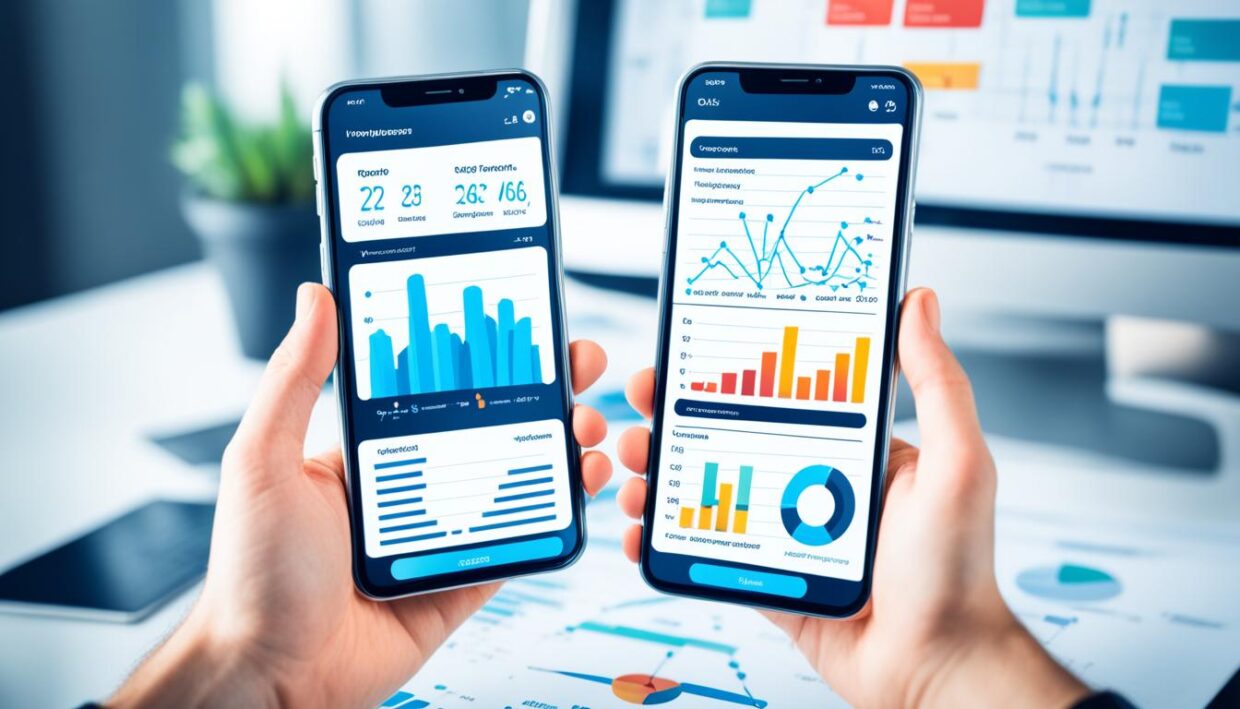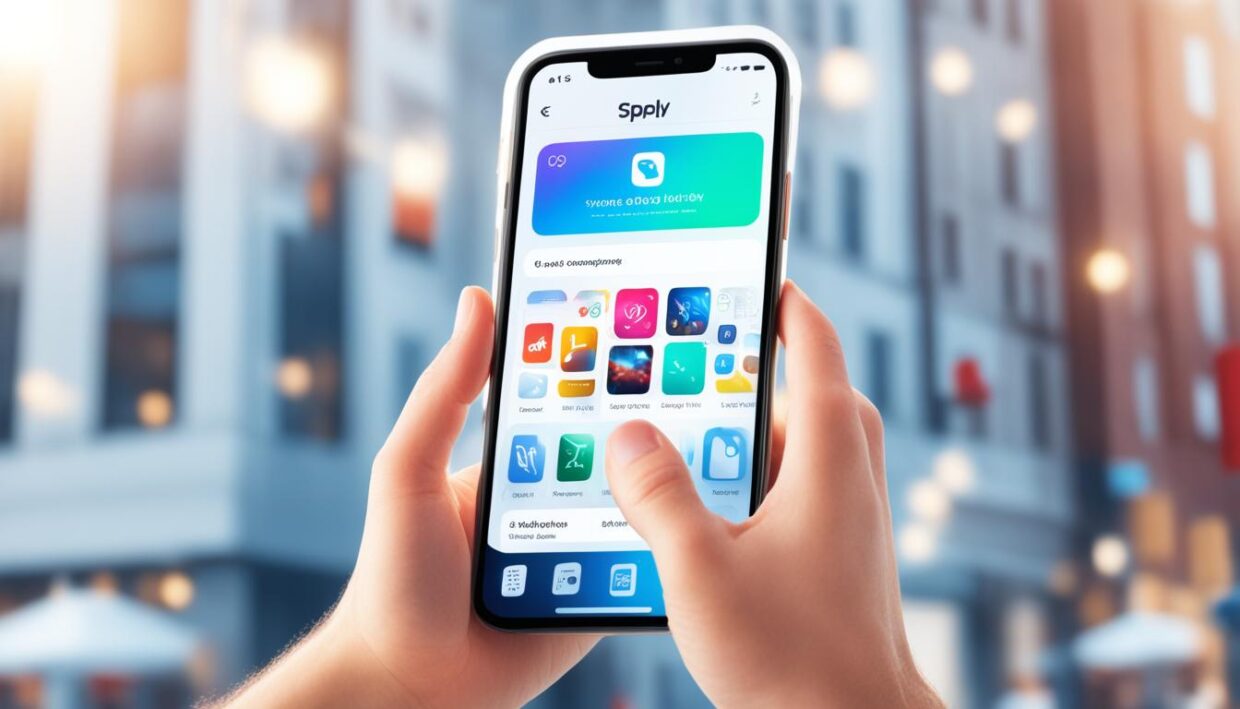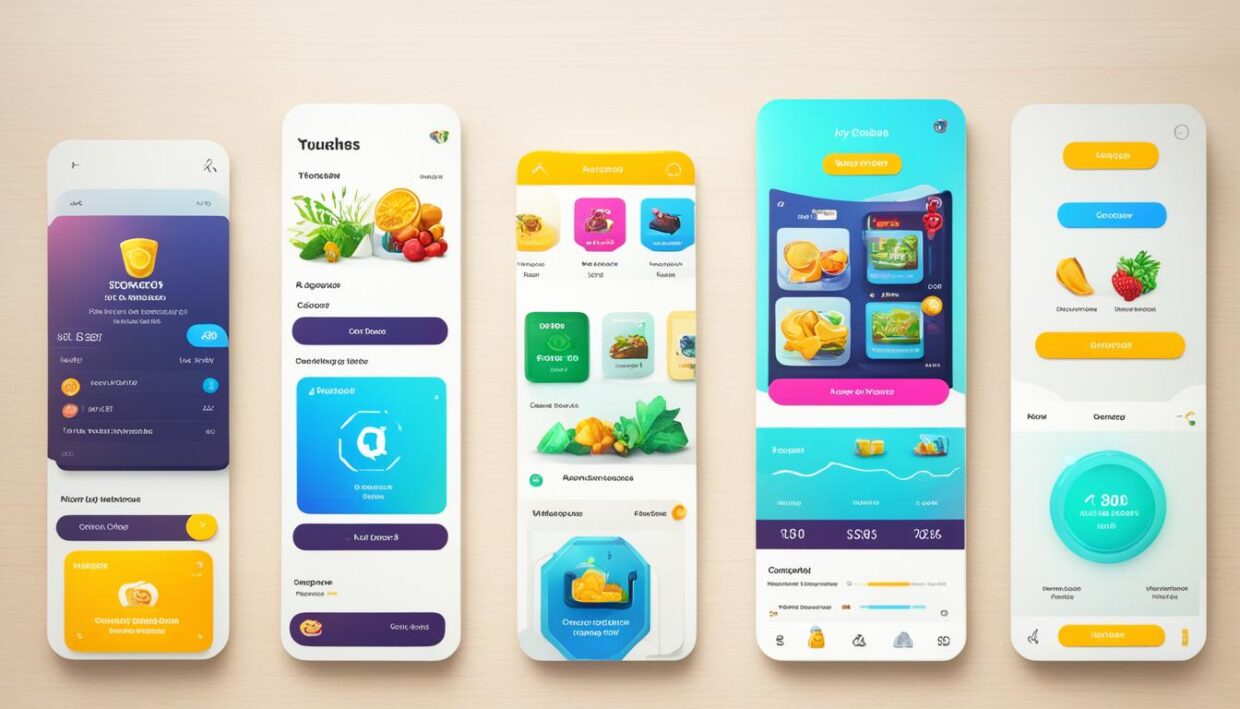
Mobile apps are redefining the landscape of business and customer interaction in today’s fast-paced digital world. With 69.4% of online shoppers gravitating towards mobile shopping apps, it’s evident that businesses must adapt to this shift to maintain engagement and efficiency. The integration of mobile apps is no longer a luxury but a necessity for enhancing user experiences and boosting customer engagement. This article will delve into the various advantages mobile apps offer, particularly in app development strategies, marketing approaches, and monetization opportunities, empowering businesses to excel in the ever-evolving digital marketplace.
Key Takeaways
- Mobile apps increase customer engagement through direct communication channels.
- Seamless user experiences lead to higher loyalty and retention rates.
- App Store Optimization (ASO) is essential for improving visibility and downloads.
- In-app purchases provide a lucrative monetization strategy for businesses.
- Emphasizing a mobile-first mindset gives companies a competitive edge.
Understanding the Mobile-First Mindset
The emergence of a mobile-first mindset highlights the shift in how users engage with digital content. Areas such as Africa demonstrate a notable trend where consumers bypass traditional web platforms, opting directly for mobile devices for news consumption. As desktop website traffic declines, particularly in the news sector, organizations must adapt to this evolving landscape.
To implement a successful mobile-first strategy, understanding mobile users is paramount. Factors to consider include user flow, bounce rates, and preferred content formats across devices. Notably, users often consume content in short, utility-driven bursts yet exhibit a growing interest in reading longer articles on mobile devices. This duality in consumption underscores the need for versatility in app development.
Given the competitiveness of social media platforms for audience attention and advertising revenue, newsrooms and other organizations must focus on enhancing mobile experiences. Journalists should explore integrating diverse content types—photos, audio, and videos—into their workflows to stay relevant in the mobile-first paradigm.
- Leverage mobile technology to connect with users effectively.
- Utilize tools such as Google Analytics for insights into user behavior.
- Employ mobile best practices by ensuring fast, responsive, and intuitive experiences.
- Incorporate unique features like geolocation and push notifications to enhance user value.
Aligning teams and strategies around this mindset fosters collaboration and innovation. Agile methodologies like Scrum or Kanban can drive effective app development processes, allowing businesses to thrive in a mobile-centric world.

Why Mobile Apps Matter in Today’s Digital Age
The importance of mobile apps has rapidly grown in recent years, reshaping the way consumers interact with brands in a digital marketplace. As the average US adult spends more than four hours daily on mobile devices, most of this time is spent engaging with applications. This trend reflects changing consumer demands, emphasizing the necessity for businesses to adapt their strategies accordingly.
Recent studies show that companies integrating mobile apps into their operations experience an impressive 25% increase in sales. Among small businesses, 49% already utilize mobile apps, while an additional 42% plan to develop one in the near future. Such statistics highlight the growing recognition of mobile apps as a vital tool for capturing consumer attention and driving revenue growth.
The customization available through mobile applications plays a significant role in enhancing customer loyalty. Around 80% of consumers are more likely to engage with companies offering personalized experiences. This trend aligns with findings that businesses investing in customer experience can see a remarkable 60% rise in revenue. Further, companies leveraging innovative app features have a 52% higher likelihood of making successful purchases through personalized recommendations.

Mobile apps not only facilitate convenience in transactions but also elevate brand perception and customer engagement. Nearly half of smartphone users interact with applications more than eleven times a day, making it crucial for businesses to meet consumer demands using user-centric features. Those that harness insights from data analytics can optimize their app experiences, ensuring they stay relevant in a competitive digital marketplace.
As mobile commerce is predicted to account for 43.4% of all e-commerce sales in 2024, the role of mobile apps in driving sales and fostering strong customer relationships cannot be overstated. Businesses that prioritize user experience will find opportunities for significant financial returns while effectively meeting the evolving needs of today’s consumers.
Enhanced User Experiences Through Mobile Apps
Enhanced user experiences are crucial for the success of mobile apps. A seamless interface with intuitive navigation can significantly impact user satisfaction. Companies prioritizing app design are better positioned to foster meaningful connections with their audience.
Statistics reveal that the average mobile user touches their device over 2,600 times per day. This high level of interaction emphasizes the necessity for an engaging experience. If an app takes more than three seconds to load, 53% of users may abandon it. To retain a loyal customer base, app developers must focus on user-friendly interfaces that promote intuitive navigation.
Engagement metrics offer insights into user experiences as well. A strong user experience correlates with higher engagement rates, allowing users to explore features more deeply. Improvements in app design can lead to a reduction in rage taps. For example, Recora achieved a 30% decrease in rage taps through effective UX changes.
| Metric | Impact of User Experience |
|---|---|
| User Growth Rate | Directly influenced by user satisfaction |
| Churn Rate | Lowered through enhanced engagement |
| Retention Rate | Increased with positive experiences |
| Session Length | Extended due to enriched user interactions |
| Daily Active Users (DAUs) | Boosted by intuitive app design |
Ultimately, a focus on quality app design, combined with continuous efforts to optimize user experiences, pays off. Companies that provide relevant recommendations resonate more with users, leading to an impressive 91% likelihood of engagement when offers align with user preferences.

Increased Customer Engagement with Mobile Apps
Mobile apps have transformed the landscape of customer engagement. They facilitate a direct line of communication with users, employing methods such as push notifications and personalized content to create a more interactive experience.
Recent statistics reveal the power of personalized messaging: 72% of consumers will engage predominantly with tailored communications. Retention rates soar with personalized push notifications, showing a remarkable 50% increase in user retention. Additionally, in-app popups contribute to a 40% rise in user engagement, keeping users interested and active.
Companies can significantly enhance their customer engagement through strategic approaches. Implementing gamification features leads to a 45% enhancement in user activity levels, urging customers to interact more with the app. Targeted email campaigns can also yield a 30% improvement in long-term engagement, driving sustained interaction with the brand.
The future of customer engagement lies in deliverable experiences tailored to the unique preferences of each user.
Custom onboarding processes can decrease drop-off rates by up to 35%, ensuring that new users feel welcomed and understood. By prioritizing personalized experiences, businesses not only gain loyal customers but also foster strong brand advocacy. Users who feel connected to a brand are more likely to recommend it to others, further amplifying its reach.
Leveraging these strategies creates a robust framework for customer engagement. A mobile app, by delivering relevant and timely information, keeps users connected and invested in the brand. The result is not only increased customer retention but also an enriching environment where users become passionate advocates for the brand.

| Engagement Strategy | Impact |
|---|---|
| Personalized Push Notifications | 50% Increase in User Retention |
| In-app Popups | 40% Increase in User Engagement |
| Targeted Email Campaigns | 30% Improvement in Long-term Engagement |
| Gamification Features | 45% Enhancement in User Activity Levels |
| Custom Onboarding | 35% Decrease in Drop-off Rates |
Defining Clear Objectives for App Development
Establishing clear objectives for app development plays a vital role in guiding the process and ensuring success. Businesses benefit significantly from setting SMART objectives: Specific, Measurable, Achievable, Relevant, and Time-bound. These goals align app functionalities with the overall strategic vision, allowing for better resource allocation and optimization.
An effective mobile app must prioritize user satisfaction and engagement, which leads to improved quality of life for users. Intuitive user interfaces are critical; they not only enhance user experiences but also play a role in retention. App development goals should focus on strategies that maintain user interest and engagement, such as personalized notifications and regularly updated content.
Monetization is often a primary goal for mobile apps, and it can take various forms, including in-app purchases, advertising, or subscription models. Therefore, incorporating data collection and analysis into mobile app design helps in continuously improving app functionality based on user behavior and preferences.
To gain a comprehensive understanding of the app’s performance, it is essential to monitor key performance indicators (KPIs). For general applications, metrics may include downloads, user engagement rates, and time spent within the app. E-commerce apps will focus on purchases, cart abandonment, conversion rates, and other related metrics. Product or brand-specific apps can examine daily active users, app store ratings, and lifetime customer value.
| Objective Type | Examples of Metrics |
|---|---|
| User Growth | Acquisition, Retention, Referral |
| Engagement | User interactions, Time spent per session |
| Brand Awareness | Search volume in app stores, App store ratings |
Frameworks such as React Native and Flutter enhance development efficiency and cross-platform compatibility, simplifying the accomplishment of these app development goals. By keeping a strategic vision in focus while defining clear objectives, businesses can craft mobile applications that resonate well with users and drive sustainable growth.

Mobile App Development: Process and Best Practices
The mobile app development journey consists of several well-defined stages that ensure a successful launch. This development process includes planning, design, development, testing, and deployment. Each phase requires careful attention to detail and adherence to best practices to optimize the outcome.

Different methods in mobile app development, such as hybrid, native, cross-platform, and web-based development, each offer distinct advantages and challenges. Understanding these options is vital for businesses aiming for a competitive edge. Major platforms including iOS and Android feature unique requirements that developers must navigate.
- Testing and Debugging: Conducting thorough testing at every stage of the development process is essential for identifying and eliminating issues.
- User Experience: Prioritizing convenience, speed, and satisfaction directly impacts app engagement. Design choices should facilitate a seamless journey regardless of user interruptions.
- Feedback Collection: Beta testing plays a critical role in refining the app. Gathering user feedback enables developers to identify areas for improvement.
- Platform Guidelines: Adhering to app development guidelines from platforms like the Play Store and App Store can prevent rejection and ensure a smoother launch.
- Regular Updates: Continuous maintenance is necessary for app stability and relevance, adapting to user needs and technology advancements.
It is important to note that adopting an analytics-driven approach enhances understanding of user behavior, which can inform marketing strategies and feature prioritization. In today’s competitive landscape, planning for personalization through data tracking leads to tailored user experiences, thereby strengthening user loyalty.
| Development Method | Advantages | Disadvantages |
|---|---|---|
| Native | Optimal performance and user experience | Higher development costs |
| Hybrid | Cost-effective and faster deployment | Potential performance issues |
| Cross-Platform | Single codebase for multiple platforms | Performance may vary across platforms |
| Web-Based | Accessible on any device with a browser | Limited functionality compared to native apps |
Incorporating best practices throughout the mobile app development process enhances not only the quality of the application but also its overall performance. Awareness of the unique needs and expectations of users, coupled with sound development strategies, can ensure success in a crowded market.
Investing in User-Centric Design for Mobile Apps
In the competitive landscape of mobile apps, investing in user-centric design is essential for driving success. Understanding user behavior, preferences, and pain points allows developers to create effective UI design that resonates with users. Statistics show that businesses prioritizing design outperform their counterparts two to one, highlighting the significance of a user-focused approach.

With 70% of all digital media time spent on mobile devices, enhancing usability through well-thought-out app design becomes increasingly crucial. Digital interactions have surpassed traditional channels, making mobile app investments vital for modern businesses. Engaging users via apps can lead to them becoming repeat customers, illustrating the potential for improved customer retention rates.
Companies that adopt user-centered design projects are 2-3 times more likely to meet their business goals. This approach not only results in higher conversion rates and sales but also bolsters brand credibility and overall customer satisfaction. A seamless user experience, from initial engagement to consistent use, can boost user loyalty, making emotional connections with users paramount.
Businesses need to continually update their mobile applications based on user feedback and advancements in technology to maximize return on investment. Integrating a user-centered design philosophy throughout the mobile app development lifecycle ensures alignment with user needs, contributing to a competitive advantage in a market boasting over 8 million applications globally.
| Aspect | Benefits |
|---|---|
| Enhanced Usability | Improved user satisfaction and engagement |
| Customer Retention | Higher chances of repeat customers |
| Business Goals | Increased likelihood of meeting business objectives |
| Competitive Advantage | Better market positioning against competitors |
| Return on Investment | Higher ROI from user-centered designs |
Ultimately, a user-centric design framework not only enriches user experiences but also sets the stage for long-term app success, ensuring that businesses keep pace with evolving user expectations in a fast-paced digital world.
The Importance of App Performance Optimization
App performance is a vital aspect of mobile application development that directly influences user satisfaction. In today’s competitive market, where fast load times are expected, optimization strategies are necessary for retaining users. A poorly performing app can lead to frustration, causing users to seek alternatives. This emphasizes the significance of employing effective methods to enhance app performance.
To maintain optimal app performance, developers should adopt several key practices. Regular performance audits help identify potential issues before they can disrupt user experience. Monitoring vital metrics provides insights into how users interact with the app and highlights areas needing improvement. Additionally, maintaining a clean codebase and using design patterns can enhance responsiveness and loading times.

Caching techniques, such as in-memory caching and disk caching, contribute significantly to reducing load times and enhancing user experience. Lazy loading and data compression further optimize app performance, resulting in smoother operational flow. Automated testing tools are essential in monitoring memory usage and conducting regular performance checks, ensuring any issues are swiftly addressed.
| Optimization Strategy | Description | Benefits |
|---|---|---|
| Caching | Storing frequent data to reduce load times. | Improved speed and responsiveness. |
| Lazy Loading | Loading only necessary content on demand. | Reduced initial load time. |
| Code Optimization | Streamlining code for better performance. | Enhanced stability and faster execution. |
| Automated Testing | Regular performance checks using tools. | Consistent user experience. |
Understanding user behavior analysis allows developers to make informed decisions that can significantly enhance app performance. As smartphone usage continues to rise, the demand for fast and responsive applications will only increase. Focused efforts in app performance optimization will yield improved user engagement and loyalty.
Leveraging App Analytics for Continuous Improvement
App analytics serves as a crucial tool for understanding user behavior and improving overall app performance. By tracking key performance indicators (KPIs) such as user engagement, retention rates, and conversion rates, businesses can gain valuable insights. Platforms like Google Analytics for Mobile, Firebase Analytics, and Mixpanel offer capabilities that allow developers to monitor these vital metrics efficiently.
Among the common KPIs, user engagement metrics such as downloads, active users, and session duration reveal how users interact with the app. Monitoring app retention rates over time supports strategies tailored for user engagement, ensuring that users remain active. For instance, a cosmetics retailer reported an impressive retention rate of 80% over six months, showcasing the effectiveness of utilizing app analytics.

A thorough analysis of user acquisition channels and marketing campaigns unveils areas for optimization. Understanding which referral sources drive traffic enables developers to adjust strategies accordingly. Additionally, monitoring app performance metrics like load times and crash reports helps in identifying and resolving app issues promptly, promoting a stable user experience.
| Metric | Description | Importance |
|---|---|---|
| User Engagement | Includes metrics like downloads and active users. | Indicates user interest and interaction levels. |
| Retention Rate | Measures user return frequency after initial download. | Essential for understanding customer loyalty. |
| Conversion Rate | Percentage of users completing a desired action. | Vital for assessing marketing effectiveness. |
| App Crashes | Reports issues and errors within the app. | Helps in troubleshooting and improving stability. |
| Average Revenue Per User (ARPU) | Measures revenue generated per active user. | Indicates financial performance and growth potential. |
Utilizing user segmentation can create personalized experiences, enhancing engagement levels further. By employing A/B testing, developers can assess variations and make informed, data-driven decisions. Ongoing analysis of these trends encourages a developmental roadmap that focuses on iterative and user-centric enhancements, driving continuous improvement.
App Marketing Strategies to Maximize Visibility
Implementing effective app marketing strategies remains essential for developers aiming to maximize visibility in a competitive marketplace. With a well-thought-out approach, businesses can significantly enhance brand awareness while engaging potential users, driving downloads, and fostering long-term retention.
- Social Media Promotions: Users spend an average of 2 hours and 24 minutes daily on social media networks. Leveraging platforms like Instagram, Facebook, and Twitter can create buzz and interest around your app.
- Influencer Partnerships: Engaging influencers in targeted campaigns proves beneficial, as authenticity is crucial for 86% of consumers when choosing to support a brand. The projected rise in influencer marketing expenditures to $6.16 billion by 2023 indicates this strategy’s growing importance.
- Email Campaigns: Email marketing remains a powerful tool, with 84% of marketers using it for user acquisition and 74% for retention. A single call to action in emails can increase clicks by 371%, showcasing the value of focusing on clear, compelling messaging.
- App Store Optimization (ASO): Ensuring a well-optimized app description is vital. The maximum character limit allows for a detailed presentation of your app’s unique features, providing potential users with essential information.

Tracking performance through analytics can contribute significantly to effective marketing efforts. Understanding user retention rates, such as Day 1 retention at 28% and Day 30 at 7%, provides valuable insights into user engagement trends. Tailoring strategies to match the behavior of the target audience is critical for maximizing both visibility and brand loyalty.
| Strategy | Benefit | Key Statistics |
|---|---|---|
| Social Media Promotions | Engagement with potential users | Average daily usage: 2h 24m |
| Influencer Partnerships | Authenticity and reach | Projected spend: $6.16 billion by 2023 |
| Email Campaigns | Higher user acquisition and retention | Clicks increase by up to 371% with clear CTAs |
| App Store Optimization | Increased downloads | Max description length: 4,000 characters |
Understanding the importance of a functional and problem-solving app is fundamental before any marketing efforts can be successfully executed. In this fast-paced digital landscape, businesses must continually refine their strategies to maintain relevance and attract users effectively.
App Store Optimization: Making Your App Stand Out
In a market where over 5.4 million apps are available across major platforms, effective app store optimization (ASO) is essential for improving visibility. This level of competition, with Apple approving nearly 1,000 new apps daily and Google Play hosting around 3.55 million apps, illustrates the need for strategic methods to enhance search rankings.
The effectiveness of ASO lies in its multifaceted approach. Key elements such as app name, descriptions, and visuals significantly impact a user’s decision to download. Prioritizing keyword research and description optimization can lead to substantial increases in organic downloads. Optimizing app store elements, including screenshots and icons, plays a vital role in improving click-through rates (CTR), directly influencing an app’s visibility in search results.
Engaging in user research is critical for understanding target audiences. Utilizing usability testing tools like Maze can streamline the process of gathering insights, allowing developers to prioritize features based on real user feedback. Positive reviews enhance visibility, presenting a clear call to action for users to leave their impressions. A consistent focus on obtaining and maintaining high ratings contributes to an app’s ranking within search results.
Innovative marketing tactics, such as content creation in the form of blog posts and videos, can create additional avenues for users to discover an app. As mobile apps are projected to generate over $935 billion in revenue by 2024, marketers must leverage app store optimization techniques effectively.
A successful ASO strategy must take into account the unique requirements of different platforms. While both Google Play and the Apple App Store share similar ranking factors, differences in keyword handling and developer guidelines can affect an app’s approval process. By focusing on app store optimization, businesses position their applications to not only stand out but also to thrive in a competitive landscape.

Driving Revenue with Mobile App Monetization
App monetization plays a crucial role in revenue generation for businesses. As the mobile app industry continues to expand, exploring diverse monetization strategies becomes essential. In 2022, worldwide spending on mobile apps reached an impressive $167 billion, with various revenue streams driving this growth.

A significant portion of this revenue comes from advertising, which accounted for almost $268 billion in 2022. Companies use ads, in-app purchases, and subscription models to create sustainable income. Statistics show that 36% of global app publishers embrace ad integration, while only 4% delve into in-app billing methods. This shows that ad-based monetization strategies dominate the market.
When considering app monetization, businesses should evaluate user experience alongside profitability. Offering valuable content ensures users remain engaged, fostering a positive relationship with the app. Therefore, it is necessary to strike a balance between profitability and user satisfaction.
Current trends indicate that consumer spending on apps varies by platform. In 2022, the Apple App Store generated $83 billion compared to $41 billion for Google Play. A staggering 97% of apps on Google Play are free, highlighting the dominance of free app models with revenue predominantly coming from ad placements.
As subscription models gain traction, revenue generation from this avenue is anticipated to soar. Forecasts suggest that by 2025, revenue from subscription model apps might reach $1.26 trillion. This trend showcases the shifting landscape of app monetization, emphasizing the importance of exploring various strategies to meet evolving user expectations.
| Monetization Strategy | Market Share (%) | 2022 Revenue (USD) |
|---|---|---|
| Advertising | 66% of app revenues | $268 billion |
| In-App Purchases | 29% of app revenues | $205 billion |
| Subscriptions | Increasing share | Forecasted to reach $1.26 trillion by 2025 |
Continually assessing and refining monetization strategies is imperative for optimizing earnings. Adopting successful app monetization practices ensures ongoing revenue growth while maintaining a user-friendly experience. Ultimately, understanding the dynamics of app monetization leads to sustainable financial success in a highly competitive marketplace.
Exploring In-App Purchase Models
In-app purchases represent a dynamic monetization model that enhances user engagement while providing apps with a steady revenue stream. This approach allows developers to offer various purchasing options, catering to diverse user preferences. Understanding the different models can significantly influence overall success.

- Auto-renewable subscriptions: Users incur charges on a recurring basis unless they cancel, allowing for continuous access to premium features.
- Non-renewing subscriptions: Users must actively repurchase to maintain access after the initial period ends.
- Consumables: Items used once and need to be repurchased once depleted, commonly found in gaming applications.
- Non-consumables: These purchases are permanent and generally include premium features accessible for a one-time payment.
Prominent applications such as Pokémon GO leverage in-app purchases by allowing players to buy in-app currency, greatly enhancing gameplay. TikTok users can purchase virtual coins to gift creators during live streams, thereby enhancing user experience further. Dating applications like Tinder offer unlimited swipes as an in-app purchase, allowing users more freedom in their interactions.
In contrast, streaming platforms like YouTube provide subscriptions that remove ads and grant access to additional content, exemplifying another effective approach to monetization. These models illustrate the versatility and potential of in-app purchases across various sectors.
Despite the benefits of generating revenue, challenges persist. Security concerns and dependence on a large user base complicate these endeavors. Furthermore, finding the right balance between monetization and user satisfaction remains crucial for sustained growth.
To enhance in-app purchases, developers can adopt strategies such as:
- Utilizing user data for personalized offerings
- Focusing on optimizing initial conversion rates
- Targeting high-value users based on engagement metrics
- Implementing timing strategies to maximize purchase likelihood
- Offering promotions and rewards to encourage spending
- Simplifying the purchase process for better accessibility
With projections showing the mobile app market could reach $2.5 trillion in revenue by 2024, understanding and effectively implementing in-app purchases is essential for developers looking to capitalize on this growing industry.
Security Considerations for Mobile Apps
The rise of mobile applications has brought unparalleled convenience alongside significant challenges in app security. Cybercriminals frequently target mobile apps, aware of their global reach and the vast amount of user data they handle. According to recent statistics, approximately 90% of the global internet population uses mobile devices. This statistic highlights the sheer volume of potential targets for malware attacks, marking a clear need for stringent security measures.
Insecure authentication practices represent a considerable risk. Applications that lack robust user verification can be easily infiltrated, especially those managing sensitive user data such as banking or social media platforms. Mobile banking applications, for instance, store critical financial information and are thus prime targets for cyber threats. Implementing security measures like two-factor authentication can significantly enhance user data protection and mitigate unauthorized access.
Rooting or jailbreaking devices introduces substantial vulnerabilities. This process allows harmful code to run undetected, threatening user privacy and paving the way for identity theft. App developers must design mobile applications with this in mind, ensuring that they operate securely on unmodified devices.
Another important aspect involves overprivileged applications. Those requesting unnecessary permissions can inadvertently expose sensitive data, leading to exploitation by malicious hackers. A clear understanding of the principle of least privilege can help developers restrict access only to what is essential, thus reducing the apps’ overall attack surface.

Third-party APIs also pose security risks. They often require access to sensitive information, which may be exploited if vulnerabilities are discovered. Common app vulnerabilities include server-side weaknesses and insecure data storage, which further complicate efforts towards effective user data protection. Regular, continuous testing methodologies are recommended to identify and address these vulnerabilities promptly.
Ultimately, a comprehensive strategy for app security incorporates effective encryption and robust session management. App shielding techniques, such as runtime application self-protection (RASP), serve as additional layers of defense against tampering and reverse-engineering attacks. By prioritizing these elements, developers can create a secure environment, ensuring that users feel confident their data is protected while they engage with mobile applications.
The Role of Emerging Technologies in Mobile Apps
Emerging technologies hold a pivotal role in revolutionizing mobile apps, shaping how users interact with digital solutions. Innovations like artificial intelligence (AI), augmented reality (AR), and blockchain are setting new standards for app functionality and user experience.
AI is particularly significant, enhancing mobile app capabilities such as predictive text, voice recognition, and personalized recommendations. For instance, apps like Google Maps leverage AI to deliver real-time traffic updates and tailored suggestions, illustrating how AI can improve everyday interactions.
AR and virtual reality (VR) are broadening horizons as well. These technologies extend beyond gaming, finding applications in education, healthcare, and real estate. By embedding AR features, developers enhance user engagement with immersive experiences.

Another critical technology, blockchain, ensures secure and transparent data storage, especially in sectors like healthcare and finance. This technology promotes trust through decentralized data management, allowing users to engage without fear of breaches.
The integration of the Internet of Things (IoT) with mobile apps facilitates seamless communication with smart devices, enhancing automation and convenience. This connectivity transforms industries, as seen with Uber’s use of IoT for real-time tracking.
Lastly, the implementation of 5G networks heralds a new era of mobile applications. With faster data transfer rates and reduced latency, developers can create sophisticated apps capable of high-definition streaming and advanced augmented reality features. As these emerging technologies continue to evolve, the mobile app landscape will undoubtedly expand, offering users new dimensions of engagement and accessibility.
Case Studies: Successful Mobile App Implementations
Exploring case studies of successful mobile apps offers invaluable insights into effective implementation strategies. These examples illustrate how strategic decisions in design, marketing, and user engagement have led to measurable success in various industries.
KLM Airlines experienced remarkable results, noting a 17% increase in visits to their mobile site, which translated into 34% more bookings and a 38% increase in mobile revenue. This case exemplifies the impact of optimizing user experience and accessibility on overall performance.
ASDA’s mobile app generated over 2 million downloads, significantly boosting mobile shopping to represent 18% of all grocery home shopping, contributing to over 90% of their sales. This demonstrates how a focused app strategy can drive user engagement and revenue.
HotelTonight achieved an impressive cost-per-download of $0.20, with 60% of new customers arriving through word-of-mouth or social media. Their marketing ROI was striking, showing a 115% return on ad spend within just one month.
BNP Paribas Wealth Management improved their app ratings from 2.5 to 4, garnering substantial press coverage and an uptick in new users. This evolution showcases the importance of continuous improvement and user feedback.
Guidecentral increased downloads by 700% after implementing a more visually appealing icon and keyword optimization, highlighting how aesthetic and functional enhancements can drastically increase user interest.
Amazon saw a traffic surge after including “shopping” in their app name, raising their global traffic percentage from 2.12% to 9.88%. This suggests that strategic naming and keyword integration can draw in significant customer traffic.
Omvana’s incorporation of relevant keywords in their app title resulted in a 125% increase in downloads, indicating that keyword focus remains a critical aspect of app marketing.
Companies like Shopkick managed to decrease their Cost Per Install (CPI) by 87% through TikTok ads, providing evidence of how targeted advertising can yield impressive cost reductions and increased registration rates.
| Company | Success Metric | Implementation Strategy |
|---|---|---|
| KLM Airlines | 17% increase in visits | Enhanced user experience |
| ASDA | 2 million downloads | Focused app strategy |
| HotelTonight | $0.20 cost-per-download | Word-of-mouth marketing |
| BNP Paribas Wealth Management | Ratings increase from 2.5 to 4 | User feedback incorporation |
| Guidecentral | 700% increase in downloads | Design optimization |
| Amazon | Traffic rose to 9.88% | Keyword integration |
| Omvana | 125% increase in downloads | Keyword focus in title |
| Shopkick | 87% decrease in CPI | Targeted ad strategies |

Conclusion
The transformative potential of mobile apps in today’s digital landscape is undeniable; they have become essential tools for fostering business growth and enhancing customer engagement. With an impressive 86% of users owning multiple devices, companies must look to leverage these platforms to deliver exceptional experiences. By prioritizing user experience and embracing the latest technologies, businesses can tap into the mobile apps potential that drives digital transformation.
As we continue to witness an influx of smartphone users—reaching approximately 5.25 billion globally in 2023—it’s clear that mobile apps play a pivotal role in today’s interactions, whether for work, learning, or entertainment. The undeniable success of applications, including Starbucks’ loyalty program attracting over 17 million subscribers, highlights how effective these tools can be in fostering user loyalty and engagement.
Ultimately, the future of mobile app development will hinge on a commitment to continuous improvement and responsiveness to user demands. Companies that focus on enhancing their services through innovative app solutions will position themselves favorably in an increasingly competitive market, firmly establishing their role in the ongoing digital transformation and promoting sustained business growth.




















Be the first to leave a comment